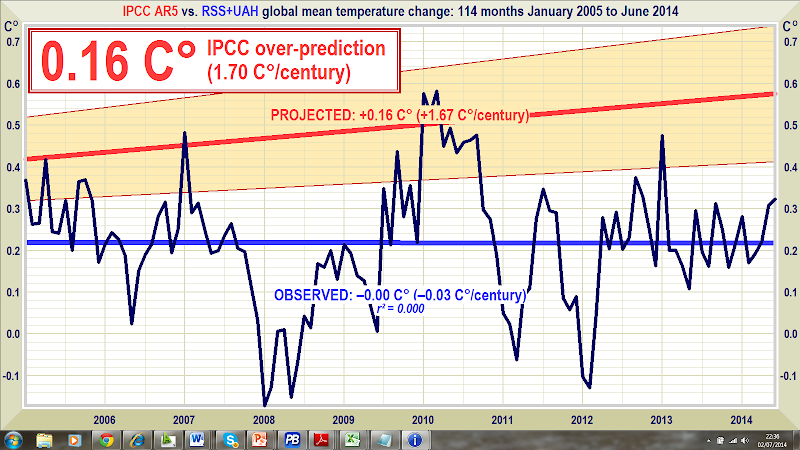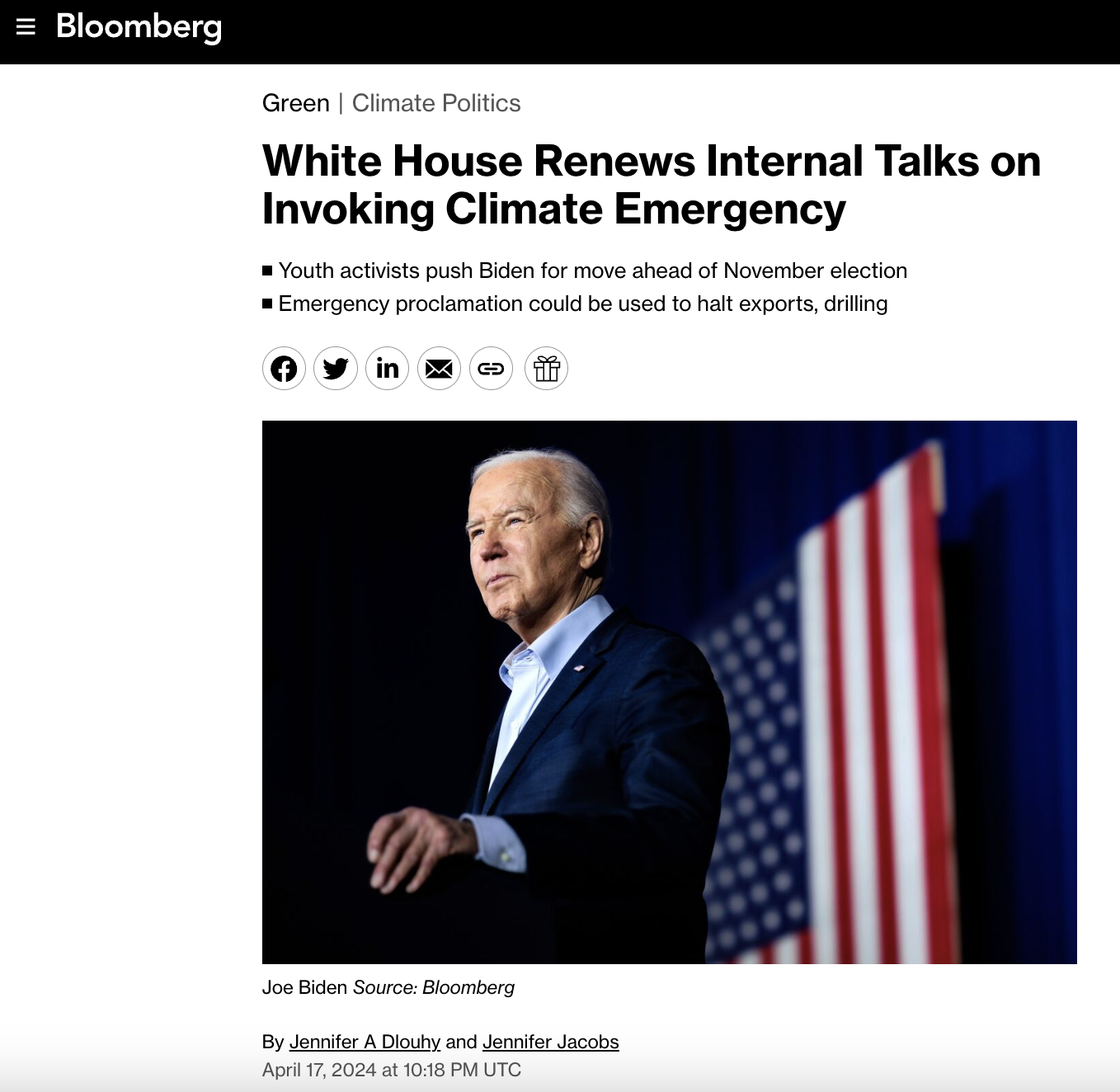Special to Climate Depot
Global Temperature Update
No global warming for 17 years 10 months
After a one-month pause in the lengthening of the pause, the lengthening pause is lengthening again.
By Christopher Monckton of Brenchley
Taking the least-squares linear-regression trend on Remote Sensing Systems’ satellite-based monthly global mean lower-troposphere temperature dataset, there has been no global warming – none at all – for 17 years 10 months. This is the longest continuous period without any warming in the global instrumental temperature record since the satellites first watched in 1979. It has endured for more than half the entire satellite temperature record. Yet the lengthening Pause coincides with a continuing, rapid increase in atmospheric CO2 concentration.

Figure 1. RSS monthly global mean lower-troposphere temperature anomalies (dark blue) and trend (thick bright blue line), September 1996 to June 2014, showing no trend for 17 years 10 months.
The hiatus period of 17 years 10 months, or 214 months, is the farthest back one can go in the RSS satellite temperature record and still show a zero trend.
Yet the length of the pause in global warming, significant though it now is, is of less importance than the ever-growing discrepancy between the temperature trends predicted by models and the far less exciting real-world temperature change that has been observed.
The First Assessment Report predicted that global temperature would rise by 1.0 [0.7, 1.5] Cº to 2025, equivalent to 2.8 [1.9, 4.2] Cº per century. The executive summary asked, “How much confidence do we have in our predictions?” IPCC pointed out some uncertainties (clouds, oceans, etc.), but concluded:
“Nevertheless, … we have substantial confidence that models can predict at least the broad-scale features of climate change. … There are similarities between results from the coupled models using simple representations of the ocean and those using more sophisticated descriptions, and our understanding of such differences as do occur gives us some confidence in the results.”
That “substantial confidence” was substantial over-confidence. A quarter-century after 1990, the outturn to date – expressed as the least-squares linear-regression trend on the mean of the RSS and UAH monthly global mean surface temperature anomalies – is 0.34 Cº, equivalent to just 1.4 Cº/century, or exactly half of the central estimate in IPCC (1990) and well below even the least estimate (Fig. 2).

Figure 2. Near-term projections of warming at a rate equivalent to 2.8 [1.9, 4.2] K/century , made with “substantial confidence” in IPCC (1990), January 1990 to June 2014 (orange region and red trend line), vs. observed anomalies (dark blue) and trend (bright blue) at 1.4 K/century equivalent. Mean of the RSS and UAH monthly satellite lower-troposphere temperature anomalies.
The Pause is a growing embarrassment to those who had told us with “substantial confidence” that the science was settled and the debate over. Nature had other ideas. Though numerous more or less implausible excuses for the Pause are appearing in nervous reviewed journals, the possibility that the Pause is occurring because the computer models are simply wrong about the sensitivity of temperature to manmade greenhouse gases can no longer be dismissed.
Remarkably, even the IPCC’s latest and much reduced near-term global-warming projections are also excessive (Fig. 3).

Figure 3. Predicted temperature change, January 2005 to June 2014, at a rate equivalent to 1.7 [1.0, 2.3] Cº/century (orange zone with thick red best-estimate trend line), compared with the observed anomalies (dark blue) and zero trend (bright blue).
In 1990, the IPCC’s central estimate of near-term warming was higher by two-thirds than it is today. Then it was 2.8 C/century equivalent. Now it is just 1.7 Cº equivalent – and, as Fig. 3 shows, even that is proving to be a substantial exaggeration.
On the RSS satellite data, there has been no global warming statistically distinguishable from zero for more than 26 years. None of the models predicted that, in effect, there would be no global warming for a quarter of a century.
The long Pause may well come to an end by this winter. An el Niño event has begun. The usual suspects have said it will be a record-breaker, but, as yet, there is too little information to say how much temporary warming it will cause. The temperature spikes caused by the el Niños of 1998, 2007, and 2010 are clearly visible in Figs. 1-3.
El Niños occur about every three or four years, though no one is entirely sure what triggers them. They cause a temporary spike in temperature, often followed by a sharp drop during the la Niña phase, as can be seen in 1999, 2008, and 2011-2012, where there was a “double-dip” la Niña.
The ratio of el Niños to la Niñas tends to fall during the 30-year negative or cooling phases of the Pacific Decadal Oscillation, the latest of which began in late 2001. So, though the Pause may pause or even shorten for a few months at the turn of the year, it may well resume late in 2015. Either way, it is ever clearer that global warming has not been happening at anything like the rate predicted by the climate models, and is not at all likely to occur even at the much-reduced rate now predicted. There could be as little as 1 Cº global warming this century, not the 3-4 Cº predicted by the IPCC.
Key facts about global temperature
- The RSS satellite dataset shows no global warming at all for 214 months from September 1996 to June 2014. That is 50.2% of the entire 426-month satellite record.
- The fastest measured centennial warming rate was in Central England from 1663-1762, at 0.9 Cº/century – before the industrial revolution. It was not our fault.
- The global warming trend since 1900 is equivalent to 0.8 Cº per century. This is well within natural variability and may not have much to do with us.
- The fastest warming trend lasting ten years or more occurred over the 40 years from 1694-1733 in Central England. It was equivalent to 4.3 Cº per century.
- Since 1950, when a human influence on global temperature first became theoretically possible, the global warming trend has been equivalent to 1.2 Cº per century.
- The fastest warming rate lasting ten years or more since 1950 occurred over the 33 years from 1974 to 2006. It was equivalent to 2.0 Cº per century.
- In 1990, the IPCC’s mid-range prediction of the near-term warming trend was equivalent to 2.8 Cº per century, higher by two-thirds than its current prediction.
- The global warming trend since 1990, when the IPCC wrote its first report, is equivalent to 1.4 Cº per century – half of what the IPCC had then predicted.
- In 2013 the IPCC’s new mid-range prediction of the near-term warming trend was for warming at a rate equivalent to only 1.7 Cº per century. Even that is exaggerated.
- Though the IPCC has cut its near-term warming prediction, it has not cut its high-end business as usual centennial warming prediction of 4.8 Cº warming to 2100.
- The IPCC’s predicted 4.8 Cº warming by 2100 is more than twice the greatest rate of warming lasting more than ten years that has been measured since 1950.
- The IPCC’s 4.8 Cº-by-2100 prediction is almost four times the observed real-world warming trend since we might in theory have begun influencing it in 1950.
- Since 1 January 2001, the dawn of the new millennium, the warming trend on the mean of 5 datasets is nil. No warming for 13 years 5 months.
- Recent extreme weather cannot be blamed on global warming, because there has not been any global warming. It is as simple as that.
Technical note
Our latest topical graph shows the RSS dataset for the 214 months September 1996 to May 2014 – more than half the 426-months satellite record.
Terrestrial temperatures are measured by thermometers. Thermometers correctly sited in rural areas away from manmade heat sources show warming rates appreciably below those that are published. The satellite datasets are based on measurements made by the most accurate thermometers available – platinum resistance thermometers, which not only measure temperature at various altitudes above the Earth’s surface via microwave sounding units but also constantly calibrate themselves by measuring via spaceward mirrors the known temperature of the cosmic background radiation, which is 1% of the freezing point of water, or just 2.73 degrees above absolute zero. It was by measuring minuscule variations in the cosmic background radiation that the NASA anisotropy probe determined the age of the Universe: 13.82 billion years.
The graph is accurate. The data are lifted monthly straight from the RSS website. A computer algorithm reads them down from the text file, takes their mean and plots them automatically using an advanced routine that automatically adjusts the aspect ratio of the data window at both axes so as to show the data at maximum scale, for clarity.
The latest monthly data point is visually inspected to ensure that it has been correctly positioned. The light blue trend line plotted across the dark blue spline-curve that shows the actual data is determined by the method of least-squares linear regression, which calculates the y-intercept and slope of the line via two well-established and functionally identical equations that are compared with one another to ensure no discrepancy between them. The IPCC and most other agencies use linear regression to determine global temperature trends. Professor Phil Jones of the University of East Anglia recommends it in one of the Climategate emails. The method is appropriate because global temperature records exhibit little auto-regression.
Dr Stephen Farish, Professor of Epidemiological Statistics at the University of Melbourne, kindly verified the reliability of the algorithm that determines the trend on the graph and the correlation coefficient, which is very low because, though the data are highly variable, the trend is flat.
Related Links:
Climate Depot Analysis: ‘There have been at least nine ten separate explanations for the standstill in global warming’ – 1) Low Solar Activity; 2) Oceans Ate Warming; 3) Chinese Coal Use; 4) Montreal Protocol; 5) Readjusted past temps to claim ‘pause’ never existed 6) Volcanoes 7) Decline in Water Vapor 8) Pacific Trade Winds 9) ’Stadium Waves’ 10) ‘Coincidence’


